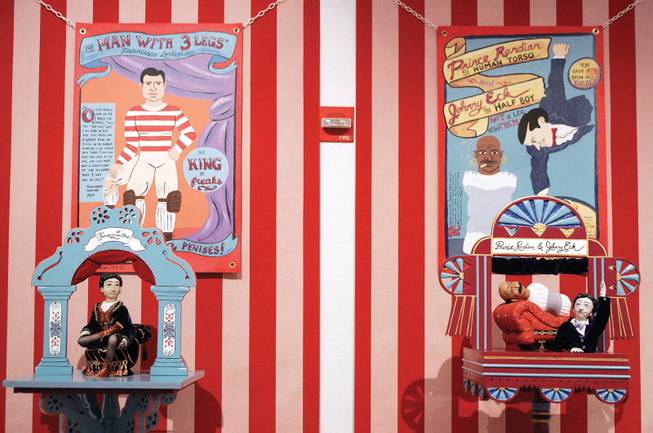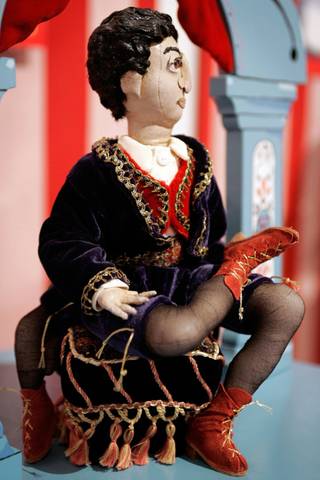
Mixed-media sculptures of famous sideshow performers are at the center of Holley Bakich’s traveling sideshow art exhibit now at the Atomic Testing Museum. The handcrafted sculptures have leather skin, stitched-in eyebrows and eyelashes that give them an eerie human quality.
Tuesday, May 6, 2008 | 2 a.m.
If You Go
- What: “Amusement Park Science” with sideshow art exhibit
- Where: Atomic Testing Museum, 755 E. Flamingo Road
- When: 9 a.m. to 5 p.m. Monday through Saturday and 1 to 5 p.m. Sunday
- Through: July 16
- Admission: $6, $4 for children; admission to the full Atomic Testing Museum is $12 for adults; $9 for seniors, Nevada residents, youth and members of the military; and free to children 6 and younger; 794-5161
Beyond the Sun
Johnny Eck had no legs. Francesco Lentini had three. Julia Pastrana had legs, but like the rest of her body — face included — they were covered in dense black hair.
Prince Randian had no legs and no arms and crawled around like a worm. He’d roll and light a cigarette using his lips.
For this, they became famous, traveled the world, befriended others and reigned during the era of sideshow oddities. Many married, had children, wintered in Gibsonton, Fla., and made their mark on history.
Freaks? That’s a relative term. What might they have said about the emaciated, falsely chested, overtanned beauties of today who bypassed the sideshow for center stage?
“I think our country has a pretty screwed up idea of what beauty is,” says Holley Bakich, an artist and designer from Milwaukee. “We need to broaden it. These people really pushed the envelope. They were very beautiful.”
Bakich spent five years creating doll-like sculptures of Eck, Lentini, Randian, Baby Thelma, Pastrana (The Bearded Lady”), Chang and Eng (“the original Siamese twins”) and other “human oddities” who traveled the circuit in the heyday of “ten-in-one” sideshows, which featured 10 acts or human oddities for a single admission price.
The sculptures are on display in conjunction with “Amusement Park Science,” an interactive exhibit that covers the physics of amusement park rides, in the Harry Reid Hall of the Atomic Testing Museum.
For a moment, you’re at an old sideshow, or the memory of one, contemplating the lives of these artists, many of whom were in Tod Browning’s 1932 film, “Freaks,” and the ethics of humans displayed as attractions.
The detailed sculptures are fascinating. The leather skin and the eyelashes jutting from around their little eyeballs give them an eerie human quality. Their handcrafted hair is perfectly groomed. Their eyebrows are stitched in.
Some are displayed in diorama settings: Lentini in a chair posing as he did in a famous photograph, and Chang and Eng in a little striped circus tent. Bakich also made their costumes, furniture, showcase stands and accompanying posters. A fan of photographer Diane Arbus, Bakich’s interest in sideshow artists took hold after reading “The Two: The Story of the Original Siamese Twins” a book about Chang and Eng. As her research continued, so did her fascination with their lives and their self-acceptance.
The American sideshows dissolved, paving the way for Jerry Springer and tabloid magazines to carry the stories and feature the oddities. Medical advancements allow for tackling certain differences when children are young. But maybe as a country we’ve also grown up a little. Conjoined teenage twins Abigail and Brittany Hensel live normal lives with family and friends in Minnesota.
Bakich is familiar with arguments of sideshow exploitation, unfair managers and that some of the acts were sold to traveling shows or given away by their parents when they were young.
Her message is that despite their physical differences and upbringings, many found a community in sideshows and succeeded in life. Randian, the limbless entertainer, could write and paint and had a wife and children. Some studied law, philosophy or music. Pastrana, born to Mexican Digger Indians, traveled the world and learned to dance and read. Her life was bittersweet. She died shortly after giving birth to an equally hairy son, and her controlling husband-manager mummified their bodies and exhibited them. Bakich doesn’t gloss over those details in her exhibit, but the approachable quality of her art does emit a sense of respect and tenderness. No pity.
“People think of the sideshow as a terrible, dirty place,” Bakich says. “They say, ‘Oh, they have had a hard life. They were put upon.’ But they didn’t think that way. They had interesting lives, fascinating lives, and how they looked at their lives is different than what most people think they should have looked at their lives. That’s the message I hope to get across.”


Join the Discussion:
Check this out for a full explanation of our conversion to the LiveFyre commenting system and instructions on how to sign up for an account.
Full comments policy